
(a)
Interpretation:
For the given proposed transforms, it is to be determined whether it leads to a synthetic trap (i.e. will not proceed as planned in the forward direction) or not along with the reasoning.
Concept introduction:
A particular reaction is undone by performing a transform that depends on the specific location in the target molecule where we want the changes to occur. In doing so, we may encounter synthetic traps. A synthetic trap is the proposed mechanism that prevents the reaction to occur in the forward direction as planned. From the reactions used for
Answer to Problem 13.6P
The synthesis will proceed as planned. The forward reaction is shown below:
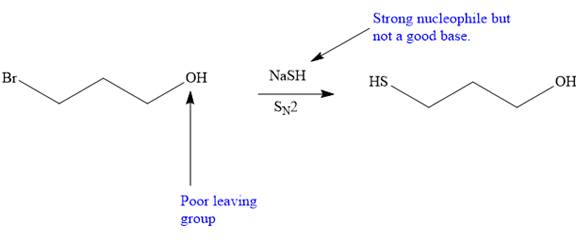
Explanation of Solution
The given proposed transform is:

The target molecule is on the left side. In the target molecule, there are two functional groups present, a cyanide and hydroxyl group. In order to carry out this transform, sodium cyanide (

Thus, the proposed transform does not lead to a synthetic trap and will proceed as planned.
The possibility of the forward reaction in the proposed mechanism is determined on the basis of the functional group transformation reactions, charge stability, and strength of the reagents used.
(b)
Interpretation:
For the given proposed transforms, it is to be determined whether it leads to a synthetic trap (i.e. will not proceed as planned in the forward direction) or not along with the reasoning.
Concept introduction:
A particular reaction is undone by performing a transform that depends on the specific location in the target molecule where we want the changes to occur. In doing so, we may encounter synthetic traps. A synthetic trap is the proposed mechanism that prevents the reaction to occur in the forward direction as planned. From the reactions used for functional group transformation and considering the factors like charge stability and strength of the reagent used, one can determine whether the proposed transform leads to a synthetic trap or not.
Answer to Problem 13.6P
The synthesis will proceed as planned. The forward reaction is shown below:
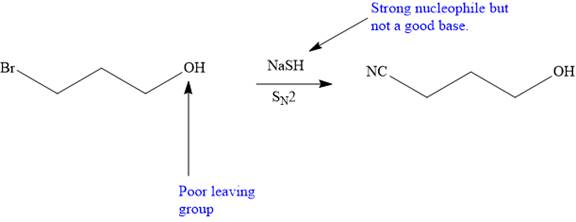
Explanation of Solution
The given proposed transform is:
![]()
The target molecule is on the left side. In the target molecule, there are two functional groups present,

Thus, the proposed transform does not lead to a synthetic trap and will proceed as planned.
The possibility of the forward reaction in the proposed mechanism is determined on the basis of the functional group transformation reactions, charge stability, and strength of the reagents used.
(c)
Interpretation:
For the given proposed transforms, it is to be determined whether it leads to a synthetic trap (i.e. will not proceed as planned in the forward direction) or not along with the reasoning.
Concept introduction:
A particular reaction is undone by performing a transform that depends on the specific location in the target molecule where we want the changes to occur. In doing so, we may encounter synthetic traps. A synthetic trap is the proposed mechanism that prevents the reaction to occur in the forward direction as planned. From the reactions used for functional group transformation, and considering the factors like charge stability and strength of the reagent used, one can determine whether the proposed transform leads to a synthetic trap or not.
Answer to Problem 13.6P
The synthesis will proceed as planned. The forward reaction is shown below:
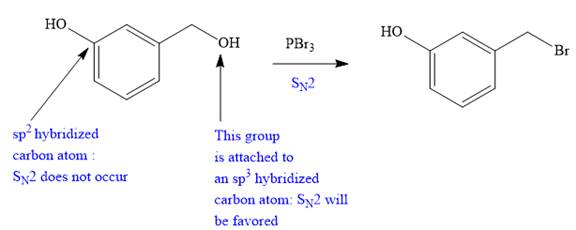
Explanation of Solution
The given proposed transform is:

The target molecule is on the left side. In the target molecule, there are two functional groups present, alkyl halide and hydroxyl group.

Thus, the proposed transform does not lead to a synthetic trap and will proceed as planned.
The possibility of the forward reaction in the proposed mechanism is determined on the basis of the functional group transformation reactions, charge stability, and strength of the reagents used.
(d)
Interpretation:
For the given proposed transforms, it is to be determined whether it leads to a synthetic trap (i.e. will not proceed as planned in the forward direction) or not along with the reasoning.
Concept introduction:
A particular reaction is undone by performing a transform that depends on the specific location in the target molecule where we want the changes to occur. In doing so, we may encounter synthetic traps. A synthetic trap is the proposed mechanism that prevents the reaction to occur in the forward direction as planned. From the reactions used for functional group transformation, and considering the factors like charge stability and strength of the reagent used, one can determine whether the proposed transform leads to the synthetic trap or not.
Answer to Problem 13.6P
The synthesis will not proceed as planned.
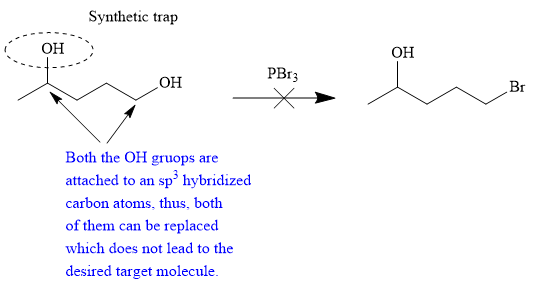
The proposed synthesis is a synthetic trap, and the reaction will not proceed as planned in the forward direction.
Explanation of Solution
The given proposed transform is:

The target molecule is on the left side while the proposed reactant molecule is on the right side. In the target molecule, there are two functional groups present, alcohol and alkyl halide. Alkyl halides are prepared from corresponding alcohols when they are treated with phosphorous bromide/chloride in an

The possibility of the forward reaction in the proposed mechanism is determined on the basis of the functional group transformation reactions, charge stability, and strength of the reagents used.
(e)
Interpretation:
For the given proposed transforms, it is to be determined whether it leads to a synthetic trap (i.e. will not proceed as planned in the forward direction) or not along with the reasoning.
Concept introduction:
A particular reaction is undone by performing a transform that depends on the specific location in the target molecule where we want the changes to occur. In doing so, we may encounter synthetic traps. A synthetic trap is the proposed mechanism that prevents the reaction to occur in the forward direction as planned. From the reactions used for functional group transformation, and considering the factors like charge stability and strength of the reagent used, one can determine whether the proposed transform leads to the synthetic trap or not.
Answer to Problem 13.6P
The synthesis will not proceed as planned.

The proposed synthesis is a synthetic trap, and the reaction will not proceed as planned in the forward direction.
Explanation of Solution
The given proposed transform is:
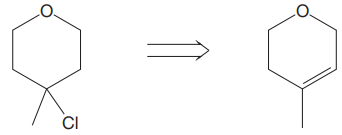
The target molecule is on the left side while the proposed reactant molecule is on the right side. In the target molecule, there are two functional groups present, ether and alkyl halide. Alkyl halides are prepared from
As the reaction does not yield the desired product, we would say that the proposed synthesis is a synthetic trap, and the reaction will not proceed as planned in the forward direction.

The possibility of the forward reaction in the proposed mechanism is determined on the basis of the functional group transformation reactions, charge stability, and strength of the reagents used.
(f)
Interpretation:
For the given proposed transforms it is to be determined whether it leads to a synthetic trap (i.e. will not proceed as planned in the forward direction) or not along with the reasoning.
Concept introduction:
A particular reaction is undone by performing a transform that depends on the specific location in the target molecule where we want the changes to occur. In doing so, we may encounter synthetic traps. A synthetic trap is the proposed mechanism that prevents the reaction to occur in the forward direction as planned. From the reactions used for functional group transformation, and considering the factors like charge stability and strength of the reagent used, one can determine whether the proposed transform leads to the synthetic trap or not.
Answer to Problem 13.6P
The synthesis will not proceed as planned.

The proposed synthesis is a synthetic trap, and the reaction will not proceed as planned in the forward direction.
Explanation of Solution
The given proposed transform is:

The target molecule is on the left side while the proposed reactant molecule is on the right side. In the target molecule, there are two functional groups present,
As the reaction does not yield the desired product, we would say that, the proposed synthesis is a synthetic trap and the reaction will not proceed as planned in the forward direction.

The possibility of the forward reaction in the proposed mechanism is determined on the basis of the functional group transformation reactions, charge stability, and strength of the reagents used.
Want to see more full solutions like this?
Chapter 13 Solutions
ORG.CHEM W/TEXT+SOLU.MANUAL
- Above each arrow, supply the reagent(s)/reaction conditions that is(are) needed for each of the followingtransformations.arrow_forwardBy following the curved red arrows, draw the product(s) of each of the following reaction steps. Also indicate which species is the electrophile and which is the nucleophile.arrow_forward(SYN) In the reaction shown here, the aromatic ring has just one chemically distinct, aromatic H, so a single electrophilic aromatic substitution will lead to just a single product. With this in mind, supply the missing reagentsneeded to carry out the transformation.arrow_forward
- Please draw a full mechanism of the reaction. Please do not copy from previously answered question.arrow_forwardPlease help and explain problemarrow_forwardThe first step should be proton transfer. As I included in my work and the second step I think should be nucleophilic attack but I don't know how to continue on from there. Please but problem as a list of reactionsarrow_forward
- What kind of transformation is shown here? Please include mechanism and reagentsarrow_forwardA pair of diastereomers is each individually mixed with a strong base, and for both an E2 reaction occurs.Provide the missing curved arrow notation, and draw the correct geometric isomer that is formed for both of the E2 mechanisms.arrow_forwardCan I have the product with a detailed mechanism a..arrow_forward
 Organic Chemistry: A Guided InquiryChemistryISBN:9780618974122Author:Andrei StraumanisPublisher:Cengage Learning
Organic Chemistry: A Guided InquiryChemistryISBN:9780618974122Author:Andrei StraumanisPublisher:Cengage Learning
